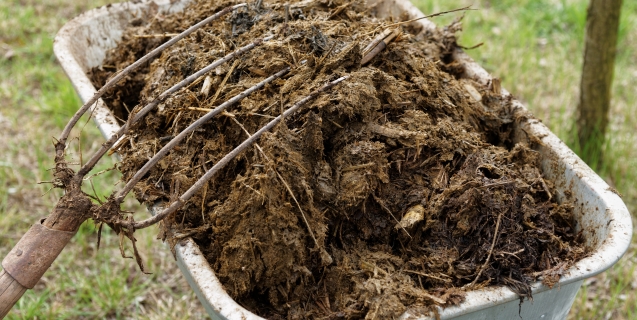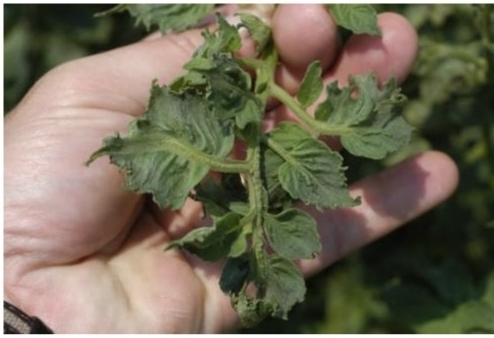
Manure
There’s an old garden saying — “feed the soil, not the plant” — and if you ask any gardener what’s the best way to feed the soil, a likely response is manure. Many gardeners consider manure to be one of our most precious resources: it adds organic matter to the soil, improves soil structure, increases water-holding capacity, and provides beneficial microbes and nutrients that plants need to flourish.
For all the benefits of using manure and manure-based composts in the garden, there are also some risks. Animal manures harbor pathogens harmful to humans, including E. Coli, Salmonella and Campylobacter bacteria, and Giardia or Cryptosporidium protozoa. Pathogens can pass from animal manure to humans through direct contact between contaminated manure and fresh fruit or vegetables.
In general there are three stages of manure: fresh or raw, aged, and composted. Each stage has different level of risk of harboring pathogens:
- Fresh or raw manure: High Risk
- Aged manure (at least 6 months old): Medium Risk; pathogens are reduced but could still be present.
- Composted manure: Lower risk; microbial pathogens are substantially reduced.
Health risks can be reduced when using manure in the home gardens by adhereing toe the following precautions:
- Wait at least 120 days after applying raw or aged manure before you harvest crops that have had contact or potential contact with the ground. This includes root crops (carrots, radishes and the like) and leafy green crops (lettuce, spinach and the like).
- Wait 90 days before harvest for those crops that do not come in contact with the ground: corn, okra, for example.
- Once the garden is planted, avoid using animal manures unless they have been composted.
- As a general rule, un-composted manure should only be incorporated into the garden in the fall.
And by the way, horse manure is notorious for spreading weed seeds into the garden. Composting kills most of the weeds.
Herbicide Residue
There have been cases where vegetable gardeners have unknowingly used manure and composts that are contaminated with widely-used herbicides — clopyralid and aminopyralid — which are used to kill broad leaf plants in golf course turf, pastures, hay crops, grain fields, and roadways.
Manure becomes contaminated when it passes through a farm animal that has eaten a herbicide-treated plant. Compost can also become contaminated when it is made with grass and leaves that have been sprayed with herbicide or when it’s made with contaminated manure. In general, herbicides do eventually breakdown and lose activity over time, particularly as they are exposed to microbes, heat and moisture; however these particular herbicides (clopyralid and aminopyralid) are simply more resistant to these natural processes.
On broadleaf crops, these herbicides can cause poor germination and kill seedlings and they cause new leaves to become twisted and malformed. Sensitive crops include a wide array of crops including tomato, potato, and other solanaceous crops, lettuce, beans and other legumes, strawberry, grapes, and most other crops except those in the cabbage family.

Distortion of tomato leaves caused by clopyralid. Photo: University of Maryland Extension
Suspected contaminated compost can be tested. Here’s how: combine some of the suspected material (compost, manure, hay or grass clippings) with a soilless mix and place it in a pot; then plant pea or bean seeds and observe what happens. Contamination is indicated if the seeds fail to germinate or if seedings emerge that are twisted and deformed.
Composting Manure
Composting manure is just like composting yard or vegetable waste. It’s not complicated, but there are some key factors to success. Composting horse manure is super easy, especially if it’s mixed with old hay or pine shavings. It’s pretty much the perfect carbon to nitrogen ratio. Everything decomposes eventually, but true composting is an accelerated decomposition process that reaches an optimum temperature (140-160oF) and sustains that temperature for a period of time — about 3 weeks. During this time, weed seeds and fly larvae are killed, while the manure decomposes. The pile continues to decompose as it cools down, with the whole process taking between 3-4 months. Many folks believe that you can’t use horse manure unless it’s at least a year old. Not true, but if the manure is “stockpiled” rather than “composted,” the decomposition process does take longer (plus it often smells bad and attracts flies).
The keys to making sure that your compost pile reaches the right temperature and doesn’t stink is air and moisture. Composting is an aerobic process (meaning that it requires air). Piles that don’t get enough air go through anaerobic decomposition, which takes longer and doesn’t reach high enough temps to kill weed and insect larvae, causing the pile to smell and attract flies. In order to keep the process aerobic, the pile either needs to be turned regularly, or it needs to have a way to draw air in, like via PVC pipes that are laid when the pile is built. The pile should also have enough moisture…the general rule of thumb is to keep the pile the consistency of a wrung out sponge. In Virginia, I find that my pile seldom gets too wet, but often needs a little extra water. For this reason, my pile is close enough to the house to reach with the hose.
I know what you’re thinking…CLOSE to the house? Yep. If it’s done right, there’s virtually no odor, no flies and it’s convenient to the flowerbeds. One tool that I find helpful in managing my compost pile is a compost thermometer. These look like giant meat thermometers, with a probe 2-3 feet long, and enable to you monitor the temperature within the pile. For smaller piles, I have also used a compost aerator -mine looks like a giant cork screw, that I drill into the pile, then pull out to create air holes. Remember the pile needs to reach that ideal temperature range, and in order to do that, you just need air and moisture.
If you have horses, don’t waste that valuable resource! If you don’t have horses, find a friend or neighbor who does and talk them into composting (or take the fresh manure home and do it yourself).
Thanks for stopping by The Garden Shed; we look forward to seeing you next month.
About the Author: Carrie Swanson is a Virginia Cooperative Extension Agent and Unit Coordinator for Albemarle County and Charlottesville, specializing in Agriculture, Natural Resources and Animal Science.
Sources:
Organic Vegetable Gardening Techniques, University of Missouri Extension, Publication G6220,http://extension.missouri.edu/p/G6220
Gardener Alert! Beware of Herbicide Contaminated Compost and Manure, University of Maryland Extension,http://extension.umd.edu/learn/gardener-alert-beware-herbicide-contaminated-compost-and-manure
HERBICIDE CARRYOVER IN HAY, MANURE, COMPOST, AND GRASS CLIPPINGS, North Carolina State University,https://content.ces.ncsu.edu/herbicide-carryover
Horse Manure Management, Virginia Cooperative Extension, Publication 406-208 https://pubs.ext.vt.edu/406/406-208/406-208.html